
Huntsman spiders, members of the family Sparassidae, are known by this name because of their speed and mode of hunting. They are also called giant crab spiders because of their size and appearance. Larger species sometimes are referred to as wood spiders, because of their preference for woody places. In southern Africa the genus Palystes are known as rain spiders or lizard-eating spiders. Commonly, they are confused with baboon spiders from the Mygalomorphae infraorder, which are not closely related.
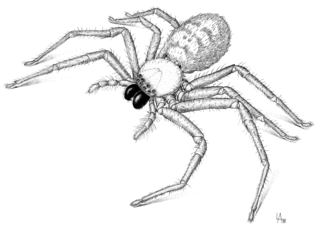
Delena cancerides, the communal huntsman, flat huntsman or social huntsman, is a large, brown huntsman spider native to Australia. It has been introduced to New Zealand, where it is sometimes known as the Avondale spider. This was the species used in the Australian movie Napoleon and widely in Arachnophobia, and all films depict them as having a deadly venomous bite, but they are generally considered harmless to humans in real-life. It was first described by Charles Athanase Walckenaer in 1837.
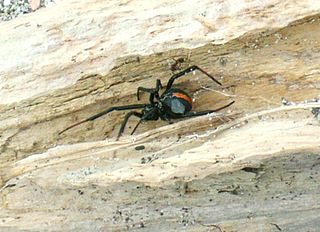
New Zealand has 1157 described spider species, with an estimated total fauna of 2000 species. Over 97 per cent are endemic, and the rest have been introduced through human activities or were natural wind-borne introductions.

Holconia is a genus of Southern Pacific huntsman spiders that was first described by Tamerlan Dahls Thorell in 1877. It was branched from Isopeda in 1990.
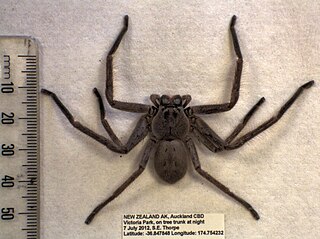
Isopeda villosa is a species of huntsman spider native to New South Wales, Australia, and established in Auckland, New Zealand. It was first described by Ludwig Carl Christian Koch in 1875.
David B. Hirst is an arachnologist previously based at the South Australian Museum in Adelaide. He left the Museum on 22 February 2011. He has described more than 40 species and genera in the huntsman spider family, Sparassidae, and was regularly called on by New Zealand authorities to identify huntsman spiders that entered their country.

Isopeda is a genus of huntsman spiders that was first described by Ludwig Carl Christian Koch in 1875.
Tychicus is a genus of huntsman spiders that was first described by Eugène Louis Simon in 1880.
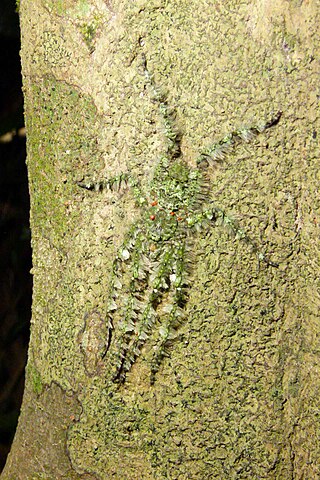
Pandercetes is a genus of huntsman spiders that was first described by Ludwig Carl Christian Koch in his 1875 treatise on Australian spiders. They are mainly distributed in tropical Asia and Australia, and are known for their cryptic coloration that matches local moss and lichen. Their legs have lateral hairs, giving them a feathery appearance, further masking their outline against tree trunks. Their head is somewhat elevated and the carapace has the thoracic region low and flat.

Desis is a genus of intertidal spiders that was first described by Charles Athanase Walckenaer in 1837. Species of the genus are found in Australasia, the Pacific, Japan, eastern and southern Africa, and India. They are marine spiders, living in the intertidal zone and only emerging at the ebb tide to hunt for invertebrates including shrimp. When submerged during high tides, they stay in an air chamber sealed with silk, and breathe its air.

Beregama is a genus of South Pacific huntsman spiders that was first described by D. B. Hirst in 1990.
Clastes is a monotypic genus of huntsman spiders containing the single species, Clastes freycineti. It was first described by Charles Athanase Walckenaer in 1837, and is found in Papua New Guinea and on the Moluccas.
Irileka is a monotypic genus of Western Australian huntsman spiders containing the single species, Irileka iridescens. It was first described by D. B. Hirst in 1998, and is found in Western Australia.
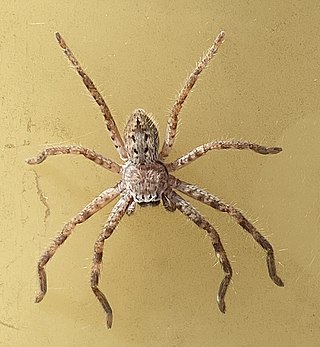
Isopedella is a genus of huntsman spiders that was first described by D. B. Hirst in 1990.
Keilira is a genus of Australian huntsman spiders that was first described by D. B. Hirst in 1989. As of September 2019 it contains two species, found in South Australia and Victoria: K. sokoli and K. sparsomaculata.

Neosparassus is a genus of huntsman spiders first described by Henry Roughton Hogg in 1903. Members of this genus most closely resemble those of Heteropoda, except that the cephalothorax is high, peaking between the midpoint and the eyes, before sloping toward the back. This angle causes the front of these spiders to appear more prominent than it actually is.
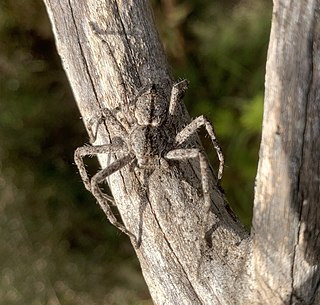
Pediana is a genus of huntsman spiders that was first described by Eugène Louis Simon in 1880.
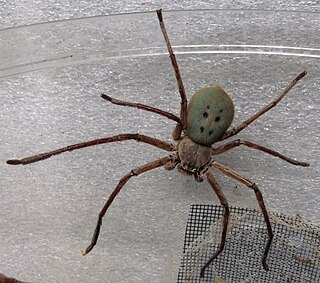
Typostola is a genus of South Pacific huntsman spiders that was first described by Eugène Louis Simon in 1897.
Zachria is a genus of Australian huntsman spiders that was first described by Ludwig Carl Christian Koch in 1875. As of September 2019 it contains two species, found in New South Wales and Western Australia: Z. flavicoma and Z. oblonga. It is not a senior synonym of Eodelena.













